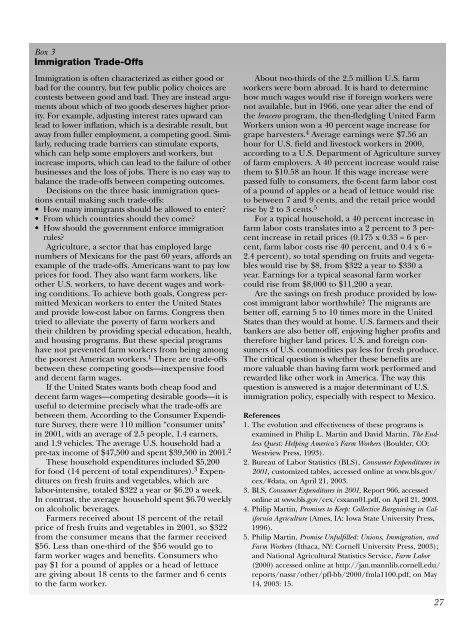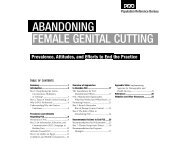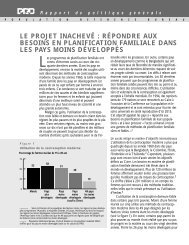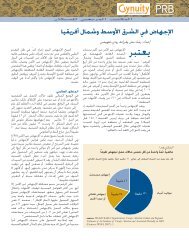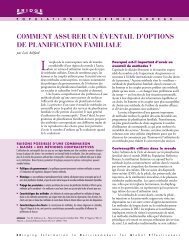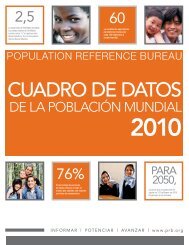Immigration Shaping America - Population Reference Bureau
Immigration Shaping America - Population Reference Bureau
Immigration Shaping America - Population Reference Bureau
You also want an ePaper? Increase the reach of your titles
YUMPU automatically turns print PDFs into web optimized ePapers that Google loves.
Box 3<br />
<strong>Immigration</strong> Trade-Offs<br />
<strong>Immigration</strong> is often characterized as either good or<br />
bad for the country, but few public policy choices are<br />
contests between good and bad. They are instead arguments<br />
about which of two goods deserves higher priority.<br />
For example, adjusting interest rates upward can<br />
lead to lower inflation, which is a desirable result, but<br />
away from fuller employment, a competing good. Similarly,<br />
reducing trade barriers can stimulate exports,<br />
which can help some employers and workers, but<br />
increase imports, which can lead to the failure of other<br />
businesses and the loss of jobs. There is no easy way to<br />
balance the trade-offs between competing outcomes.<br />
Decisions on the three basic immigration questions<br />
entail making such trade-offs:<br />
• How many immigrants should be allowed to enter?<br />
• From which countries should they come?<br />
• How should the government enforce immigration<br />
rules?<br />
Agriculture, a sector that has employed large<br />
numbers of Mexicans for the past 60 years, affords an<br />
example of the trade-offs. <strong>America</strong>ns want to pay low<br />
prices for food. They also want farm workers, like<br />
other U.S. workers, to have decent wages and working<br />
conditions. To achieve both goals, Congress permitted<br />
Mexican workers to enter the United States<br />
and provide low-cost labor on farms. Congress then<br />
tried to alleviate the poverty of farm workers and<br />
their children by providing special education, health,<br />
and housing programs. But these special programs<br />
have not prevented farm workers from being among<br />
the poorest <strong>America</strong>n workers. 1 There are trade-offs<br />
between these competing goods—inexpensive food<br />
and decent farm wages.<br />
If the United States wants both cheap food and<br />
decent farm wages—competing desirable goods—it is<br />
useful to determine precisely what the trade-offs are<br />
between them. According to the Consumer Expenditure<br />
Survey, there were 110 million “consumer units”<br />
in 2001, with an average of 2.5 people, 1.4 earners,<br />
and 1.9 vehicles. The average U.S. household had a<br />
pre-tax income of $47,500 and spent $39,500 in 2001. 2<br />
These household expenditures included $5,200<br />
for food (14 percent of total expenditures). 3 Expenditures<br />
on fresh fruits and vegetables, which are<br />
labor-intensive, totaled $322 a year or $6.20 a week.<br />
In contrast, the average household spent $6.70 weekly<br />
on alcoholic beverages.<br />
Farmers received about 18 percent of the retail<br />
price of fresh fruits and vegetables in 2001, so $322<br />
from the consumer means that the farmer received<br />
$56. Less than one-third of the $56 would go to<br />
farm worker wages and benefits. Consumers who<br />
pay $1 for a pound of apples or a head of lettuce<br />
are giving about 18 cents to the farmer and 6 cents<br />
to the farm worker.<br />
About two-thirds of the 2.5 million U.S. farm<br />
workers were born abroad. It is hard to determine<br />
how much wages would rise if foreign workers were<br />
not available, but in 1966, one year after the end of<br />
the bracero program, the then-fledgling United Farm<br />
Workers union won a 40 percent wage increase for<br />
grape harvesters. 4 Average earnings were $7.56 an<br />
hour for U.S. field and livestock workers in 2000,<br />
according to a U.S. Department of Agriculture survey<br />
of farm employers. A 40 percent increase would raise<br />
them to $10.58 an hour. If this wage increase were<br />
passed fully to consumers, the 6-cent farm labor cost<br />
of a pound of apples or a head of lettuce would rise<br />
to between 7 and 9 cents, and the retail price would<br />
rise by 2 to 3 cents. 5<br />
For a typical household, a 40 percent increase in<br />
farm labor costs translates into a 2 percent to 3 percent<br />
increase in retail prices (0.175 x 0.33 = 6 percent,<br />
farm labor costs rise 40 percent, and 0.4 x 6 =<br />
2.4 percent), so total spending on fruits and vegetables<br />
would rise by $8, from $322 a year to $330 a<br />
year. Earnings for a typical seasonal farm worker<br />
could rise from $8,000 to $11,200 a year.<br />
Are the savings on fresh produce provided by lowcost<br />
immigrant labor worthwhile? The migrants are<br />
better off, earning 5 to 10 times more in the United<br />
States than they would at home. U.S. farmers and their<br />
bankers are also better off, enjoying higher profits and<br />
therefore higher land prices. U.S. and foreign consumers<br />
of U.S. commodities pay less for fresh produce.<br />
The critical question is whether these benefits are<br />
more valuable than having farm work performed and<br />
rewarded like other work in <strong>America</strong>. The way this<br />
question is answered is a major determinant of U.S.<br />
immigration policy, especially with respect to Mexico.<br />
<strong>Reference</strong>s<br />
1. The evolution and effectiveness of these programs is<br />
examined in Philip L. Martin and David Martin, The Endless<br />
Quest: Helping <strong>America</strong>’s Farm Workers (Boulder, CO:<br />
Westview Press, 1993).<br />
2. <strong>Bureau</strong> of Labor Statistics (BLS), Consumer Expenditures in<br />
2001, customized tables, accessed online at www.bls.gov/<br />
cex/#data, on April 21, 2003.<br />
3. BLS, Consumer Expenditures in 2001, Report 966, accessed<br />
online at www.bls.gov/cex/csxann01.pdf, on April 21, 2003.<br />
4. Philip Martin, Promises to Keep: Collective Bargaining in California<br />
Agriculture (Ames, IA: Iowa State University Press,<br />
1996).<br />
5. Philip Martin, Promise Unfulfilled: Unions, <strong>Immigration</strong>, and<br />
Farm Workers (Ithaca, NY: Cornell University Press, 2003);<br />
and National Agricultural Statistics Service, Farm Labor<br />
(2000) accessed online at http://jan.mannlib.cornell.edu/<br />
reports/nassr/other/pfl-bb/2000/fmla1100.pdf, on May<br />
14, 2003: 15.<br />
27


